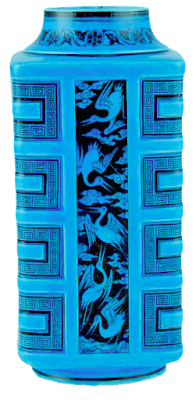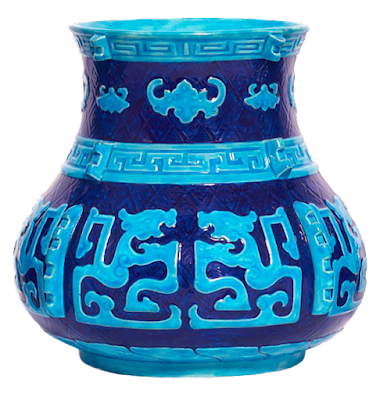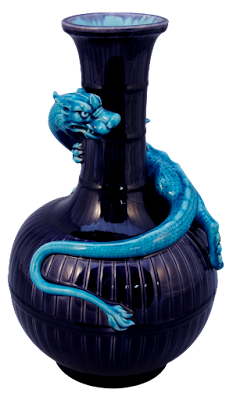One the most significant potters working in ceramics in the 19th century was Frenchman Joseph Théodore Deck. Largely unknown today outside of France, his importance in the development of the art of faïence and his influence on large English potteries like Minton cannot be overstated.
Born in Guebwiller, Haut-Rhin, Alsace France on January 2, 1823 to Richard Deck and his second wife Marguerite, he began his career in pottery at the age of seventeen when both his parents died and he was left to fend for himself and his younger brother Xavier. He became an apprentice learning ceramics from stove builder Victor-Joseph Hugelin in Strasbourg. Mentored by Hugelin he learned glazing and enamel decoration in faïence for inlay tiles in cast iron stoves.
From there he traveled extensively throughout central Europe, working as an apprentice stove maker in Budapest, Prague, Berlin, and Vienna where he learned what he could from master ceramicists. His move to Paris led to his work as a manager at the Dumas Company. Their participation in the 1851 London International Exhibition was where he first saw the revolutionary majolica glazes invented by Minton. His work with Madame Dumas allowed him the freedom to experiment with his own glazes.
This ultimately led to the 1856 establishment of a workshop he called the Faïences d’Art Théodore Deck, founded with his brother and his nephew. It was his interest in Iznik ceramics and recreating ancient transparent ceramic techniques that led him to the discovery of a glaze he called le bleu de Deck in 1859, an electric majolica blue glaze that produced a deep turquoise blue.
At the 1862 Universal Exposition in London he caught the attention of the ceramic world when he exhibited the revolutionary bleu de Deck and the earthenware Alhambra Vase, both of which caused a sensation with their technical excellence. It began a renewed interest in Islamic pottery styles throughout Europe.
Bleu de Deck influenced Minton's invention of their Royal Persian Blue several years later as it did the turquoise majolica glazes of Royal Worcester, Bretby, Burmantofts, Wedgwood and others. Deck's majolica work was highly regarded in Britain, so much so that he was offered a share in a pottery in Leeds by Colin Minton Campbell, which he declined.
In 1869 he opened his own retail shop in Paris. He produced enameled decorated ware with experimental transparent glazes and bleu de Deck in the newly fashionable Aesthetic style as well as the Chinese, Japanese and Alhambra styles. He worked on a wide variety of subjects and earthenware media. He also did architectural work with the tile at the Hôtel de la Comtesse de Païva in Paris. His revolutionary work with metallics was later imitated by numerous other potters.
In many cases his work is easily recognizable by its distinctive look. His use of bleu de Deck as well as its intricately hand done enamel and transfer decoration covered with transparent lead glaze over an opaque white tin base created finished products unlike any other being done in Europe at the time. His work is usually marked TH DECK.
His regular participation in international expositions solidified his reputation as a master of intense ceramic color. His exhibit at the 1889 Exposition Universelle de Paris won him the French Legion of Honour.
He published his findings in ceramics in 1887 in a book he called La Faïence.
After working for thirteen years as developer of commissions, in 1888 he was made institutional director for the prestigious Manufacture de Sèvres factory, a position he accepted in spite of declining health.
He died suddenly in Paris on May 15, 1891. He is buried in Montparnasse Cemetery in a grave designed by Auguste Bartholdi, sculptor of the Statue of Liberty, decorated with jonquils of Deck’s own design. The tomb reads, "He tore the fire from the sky."
Today Deck is considered a seminal artist in the development of French faïence whose influence revolutionized the potential of majolica glazes as well as other ceramics throughout Europe.
For more information there is a museum devoted to his life and work in his hometown of Guebwiller, Musée Théodore Deck.







































































Great Job, very useful, many thanks !
ReplyDeleteBy the way I recognized some of my sold pieces
ReplyDelete